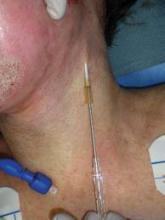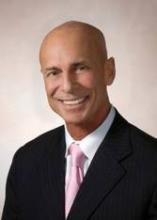User login
LAS VEGAS – Tripling the concentration of epinephrine in tumescent anesthesia used during facelift procedures has its benefits, according to Joseph Niamtu III, D.M.D.
His preferred solution consists of 1 L normal saline, 1 g lidocaine, and 3 mL epinephrine 1:1,000. "Most clinicians use 1 mL of epinephrine 1:1,000," he said at the annual meeting of the American Academy of Cosmetic Surgery. Using a higher concentration of epinephrine "certainly has faster onset of branching, it’s more robust branching, and the branching lasts longer," said Dr. Niamtu, who has a cosmetic facial surgery practice in Midlothian, Va.
"Over the years, I’ve shaved these procedures down from 4 hours to a little over 2 hours, and this is one of the things that have helped. You get a higher level of pain control, and I’ve not had any disadvantages – no discernible changes in blood pressure or epinephrine-related problems."
Dr. Niamtu also finds that facelift results can be optimized without using bulky dressings. "Patients hate dressings," he said. "They don’t prevent hematoma but they do prevent visualization of the flap. They can constrict the flap and lead to breakdown, and they abrade laser tissue."
Of the 71 facelift procedures he performed in 2011, 45% were done with simultaneous CO2 laser. "The problem was, overnight, the dressings would abrade the freshly lasered skin," he explained. "It’s problematic because the treatment site would take longer to heal and sometimes would start to form a scar." He started decreasing his use of facelift dressings "until I just didn’t use any at all." Now, he said, "it’s certainly easy to promote facelifts [with this approach]. There’s less trepidation when patients know they don’t have to wear these bulky dressings after their surgery."
The need for postoperative drains to promote the release of serum, tumescence, and blood products can be another drawback to facelifts. However, Dr. Niamtu devised a solution: a "vent" system that consists of a 14-gauge Angiocath needle placed subcutaneously in the lowest part of the flap, parallel to the sternocleidomastoid muscle, and left overnight on the day of surgery. "These will drain," he said. "Most of these patients are sitting up in a recliner or have their head propped up on pillows the night of their surgery, so they really drain. It’s secured with a mesh elastic gauze and gauze fluffs. We give the patient a lot of these fluffs, because they have to change the dressing overnight, sometimes two or three times. We use these for 24 hours after surgery."
With this approach "I think I’m seeing less bruising, my patients have a tighter neck, and they’re really not bothered by the vent," he said.
In a later interview, Dr. Niamtu said that he is not a fan of short scar facelifts because "I think it is appropriate for only the smallest lifts, and most people – even those in their early 40s – would benefit from a more comprehensive lift. I think there is a trend to do anything to avoid a 4-inch postauricular incision, [but I] feel that without this incision, short scar lifts are flawed.
"It is this posterior incision that allows true tightening of the neck, and eliminating it causes bunching behind the ear as well as shortchanges [the patient] in terms of result and longevity. I am not saying there is never a place for short scar lifts, as there is, but I have seen too much relapse or compromise in results for many patients [who] got a small lift and in reality needed a bigger one."
Dr. Niamtu said that he had no relevant financial conflicts to disclose.
LAS VEGAS – Tripling the concentration of epinephrine in tumescent anesthesia used during facelift procedures has its benefits, according to Joseph Niamtu III, D.M.D.
His preferred solution consists of 1 L normal saline, 1 g lidocaine, and 3 mL epinephrine 1:1,000. "Most clinicians use 1 mL of epinephrine 1:1,000," he said at the annual meeting of the American Academy of Cosmetic Surgery. Using a higher concentration of epinephrine "certainly has faster onset of branching, it’s more robust branching, and the branching lasts longer," said Dr. Niamtu, who has a cosmetic facial surgery practice in Midlothian, Va.
"Over the years, I’ve shaved these procedures down from 4 hours to a little over 2 hours, and this is one of the things that have helped. You get a higher level of pain control, and I’ve not had any disadvantages – no discernible changes in blood pressure or epinephrine-related problems."
Dr. Niamtu also finds that facelift results can be optimized without using bulky dressings. "Patients hate dressings," he said. "They don’t prevent hematoma but they do prevent visualization of the flap. They can constrict the flap and lead to breakdown, and they abrade laser tissue."
Of the 71 facelift procedures he performed in 2011, 45% were done with simultaneous CO2 laser. "The problem was, overnight, the dressings would abrade the freshly lasered skin," he explained. "It’s problematic because the treatment site would take longer to heal and sometimes would start to form a scar." He started decreasing his use of facelift dressings "until I just didn’t use any at all." Now, he said, "it’s certainly easy to promote facelifts [with this approach]. There’s less trepidation when patients know they don’t have to wear these bulky dressings after their surgery."
The need for postoperative drains to promote the release of serum, tumescence, and blood products can be another drawback to facelifts. However, Dr. Niamtu devised a solution: a "vent" system that consists of a 14-gauge Angiocath needle placed subcutaneously in the lowest part of the flap, parallel to the sternocleidomastoid muscle, and left overnight on the day of surgery. "These will drain," he said. "Most of these patients are sitting up in a recliner or have their head propped up on pillows the night of their surgery, so they really drain. It’s secured with a mesh elastic gauze and gauze fluffs. We give the patient a lot of these fluffs, because they have to change the dressing overnight, sometimes two or three times. We use these for 24 hours after surgery."
With this approach "I think I’m seeing less bruising, my patients have a tighter neck, and they’re really not bothered by the vent," he said.
In a later interview, Dr. Niamtu said that he is not a fan of short scar facelifts because "I think it is appropriate for only the smallest lifts, and most people – even those in their early 40s – would benefit from a more comprehensive lift. I think there is a trend to do anything to avoid a 4-inch postauricular incision, [but I] feel that without this incision, short scar lifts are flawed.
"It is this posterior incision that allows true tightening of the neck, and eliminating it causes bunching behind the ear as well as shortchanges [the patient] in terms of result and longevity. I am not saying there is never a place for short scar lifts, as there is, but I have seen too much relapse or compromise in results for many patients [who] got a small lift and in reality needed a bigger one."
Dr. Niamtu said that he had no relevant financial conflicts to disclose.
LAS VEGAS – Tripling the concentration of epinephrine in tumescent anesthesia used during facelift procedures has its benefits, according to Joseph Niamtu III, D.M.D.
His preferred solution consists of 1 L normal saline, 1 g lidocaine, and 3 mL epinephrine 1:1,000. "Most clinicians use 1 mL of epinephrine 1:1,000," he said at the annual meeting of the American Academy of Cosmetic Surgery. Using a higher concentration of epinephrine "certainly has faster onset of branching, it’s more robust branching, and the branching lasts longer," said Dr. Niamtu, who has a cosmetic facial surgery practice in Midlothian, Va.
"Over the years, I’ve shaved these procedures down from 4 hours to a little over 2 hours, and this is one of the things that have helped. You get a higher level of pain control, and I’ve not had any disadvantages – no discernible changes in blood pressure or epinephrine-related problems."
Dr. Niamtu also finds that facelift results can be optimized without using bulky dressings. "Patients hate dressings," he said. "They don’t prevent hematoma but they do prevent visualization of the flap. They can constrict the flap and lead to breakdown, and they abrade laser tissue."
Of the 71 facelift procedures he performed in 2011, 45% were done with simultaneous CO2 laser. "The problem was, overnight, the dressings would abrade the freshly lasered skin," he explained. "It’s problematic because the treatment site would take longer to heal and sometimes would start to form a scar." He started decreasing his use of facelift dressings "until I just didn’t use any at all." Now, he said, "it’s certainly easy to promote facelifts [with this approach]. There’s less trepidation when patients know they don’t have to wear these bulky dressings after their surgery."
The need for postoperative drains to promote the release of serum, tumescence, and blood products can be another drawback to facelifts. However, Dr. Niamtu devised a solution: a "vent" system that consists of a 14-gauge Angiocath needle placed subcutaneously in the lowest part of the flap, parallel to the sternocleidomastoid muscle, and left overnight on the day of surgery. "These will drain," he said. "Most of these patients are sitting up in a recliner or have their head propped up on pillows the night of their surgery, so they really drain. It’s secured with a mesh elastic gauze and gauze fluffs. We give the patient a lot of these fluffs, because they have to change the dressing overnight, sometimes two or three times. We use these for 24 hours after surgery."
With this approach "I think I’m seeing less bruising, my patients have a tighter neck, and they’re really not bothered by the vent," he said.
In a later interview, Dr. Niamtu said that he is not a fan of short scar facelifts because "I think it is appropriate for only the smallest lifts, and most people – even those in their early 40s – would benefit from a more comprehensive lift. I think there is a trend to do anything to avoid a 4-inch postauricular incision, [but I] feel that without this incision, short scar lifts are flawed.
"It is this posterior incision that allows true tightening of the neck, and eliminating it causes bunching behind the ear as well as shortchanges [the patient] in terms of result and longevity. I am not saying there is never a place for short scar lifts, as there is, but I have seen too much relapse or compromise in results for many patients [who] got a small lift and in reality needed a bigger one."
Dr. Niamtu said that he had no relevant financial conflicts to disclose.
EXPERT ANALYSIS FROM THE ANNUAL MEETING OF THE AMERICAN ACADEMY OF COSMETIC SURGERY

